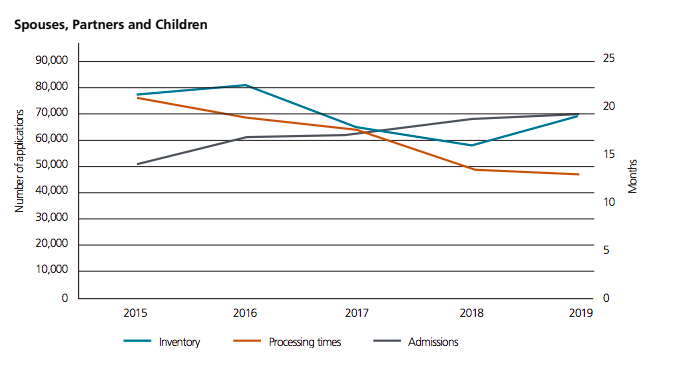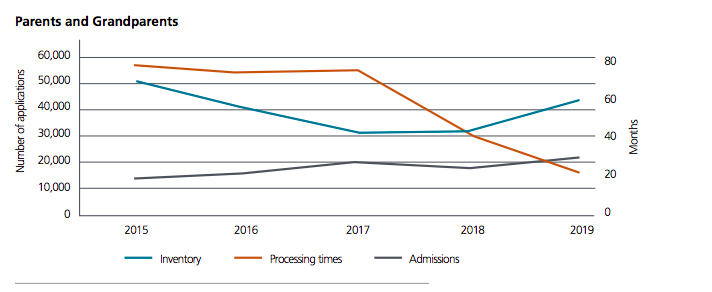Canada’s Policy on Family Reunification
The family reunification policy is based on the notion of “sponsorship” — Canadian citizens and permanent residents can sponsor their close relatives to come to Canada as permanent residents. This article describes the Canada’s family immigration programs:
RELATED ARTICLES
Canada has a long tradition of favouring family reunification in its immigration policies. The 1976 Immigration Act formally defined the objective of family reunification as “to facilitate the reunion in Canada of Canadian citizens and permanent residents with their close relatives from abroad.” But the concept of reuniting families through the country's immigration policy had existed since 1908. However, the range of persons who have been included in the family reunification category has varied over the years; they have ranged from only spouses and unmarried minors to relatives of varying degree. Most often, the policy has depended on the current economic situation of Canada; for example, during the Great Depression, only spouses and minor children were eligible and all other types of relatives were ineligible.
In the 1960s, the Government refined its immigration policies to focus on labour market needs and to reduce the number and range of relatives who would be eligible. The concept of “Sponsored” and “Nominated” relatives was introduced. Sponsored Relative had to meet only the sponsorship requirements, while Nominated Relative members had to additionally meet labour-market requirements (such as having a job offer, etc.).
But this approach was liberalized with the adoption of the 1976 Immigration Act and Family Class immigration came to dominate the migrant flow, representing 40-50% of total immigration to Canada. In 1988, unmarried sons and daughters of any age were permitted to immigrate as dependents of sponsored parents in a program now known as “J-88.” Thus, the whole extended family could tag along with a single Family Class immigrant. The very next year (in 1989) this resulted in a large upswing when family reunification based immigrants almost doubled from 53,000 to 104,000 persons. It took several years for Canada’s Immigration Department to catch up to this backlog of cases. In 1993, the government discontinued the “Nominated Relative” (also called “Assisted Relative”) program and fully separated its economic (i.e. job-based) and family immigration programs.
In 2001, the Immigration and Refugee Protection Act was passed. It laid the foundations of Canada’s current Family Class Sponsorship program. The range of relatives who could be sponsored was tightened again. For example, only dependent children were deemed eligible to be sponsored by their parents. Furthermore, the process of sponsoring relatives was made more rigorous resulting in extremely long waiting times that sometimes exceeded 80 months (especially for applications for parents or grandparents).
By 2017, the procedures were streamlined and the processing time was reduced to 12 months for spouses or partners and dependent children, and to 24 months for parents and grandparents. Today, family reunification is handled through a set of well-defined sponsorship immigration programs that allow eligible sponsors to bring their family members to Canada as permanent residents. These programs are managed by the Immigration, Refugees, and Citizenship Canada (IRCC) department. Sponsors can be a) permanent residents of Canada who will be living continuously in Canada when their sponsored person comes to Canada or b) citizens of Canada. To become a sponsor, a person must meet a set of requirements. A Sponsor must accept financial responsibility for their sponsored person for a defined period. This commitment by the Sponsor is documented in a written agreement called an Undertaking. Categories of persons who may obtain permanent residency through family reunification include:
The Canadian government defines Family Reunification as an important tool for attracting, retaining, and integrating newcomers. It recognizes that immigrants feel more comfortable and are better engaged in social and civic life when they are surrounded by their relatives. Family support can play an important role in the success, resilience, and productivity of newcomers, which in turn results in economic benefits for Canada. Note that on average, immigrants under the Family Class do not experience the same level of economic success as that of economic immigrants, but their success is stronger than that of refugees to the country. Research shows that their economic outcomes improve the longer they stay in Canada.
Family reunification is often coupled with other immigration classes. For example, an economic immigrant may initially come to Canada alone but later sponsor other relatives from his or her country of origin. Another example is a temporary resident (such as a student or a worker) who meets and marries a Canadian, and subsequently seeks permanent residence as a sponsored spouse.
Canada IRCC’s research shows that family reunification has several other social benefits: improved mental health outcomes, reduced interactions with law enforcement, higher new business formation, lower dependence on welfare system, etc. Arrival of new family members has an “anchoring” effect on the sponsor, newly arrived family members and their communities.
Spousal Sponsorship
Canadian permanent residents or citizens may sponsor their non-Canadian spouse, common-law or conjugal partner after the applications of both of them have been approved by the IRCC. Candidates in same-sex relationships are not discriminated in any manner by the Canadian government. Even if the relationship between a sponsor and a sponsored person (spouse or partner) breaks down, the spouse’s permanent resident status is not affected.
Dependent Children Sponsorship
Canadian permanent residents or citizens may sponsor their biological or adopted dependent children. The children are considered dependent if they are under 22 years of age and do not have a spouse or partner, or their own dependent children. Please note that adopted children from other countries may also be sponsored to come to Canada as permanent residents.
Parents and Grandparents Sponsorship
Canadian permanent residents or citizens may sponsor their parents and grandparents to come to Canada and obtain permanent residence. Sponsors must meet the minimum financial requirements to be able to support them, so that the parents or grandparents will not seek assistance from the Canadian government. Note that there is an alternative method to bring parents and grandparents to visit Canada for an extended period, called a Super Visa. The Super Visa is approved very quickly. However, it only grants temporary resident status.
Sponsorship of Other Relatives
Canadian permanent residents or citizens may sponsor other relatives such as a brother, sister, aunt, or uncle in very specific situations that are defined in the Canadian legislation.
Quebec Family Reunification
Quebec manages its immigration programs differently from other provinces and territories of Canada. In Quebec, the program is called the Family Reunification Class sponsorship program. The application and verification process for both a Sponsor and a sponsored person is under the joint responsibility of IRCC and the Quebec Ministry of Immigration. Quebec authorities determine whether or not Sponsors residing in Quebec have the financial capability to sponsor members of the family class.
The percentage of immigration admissions under sponsorship immigration during the last decade is 27% of the total immigrants. This is mostly due to limitations on the number of immigrants established annually by the Canadian government: if the Government plans to admit a certain number of immigrants under the specific program (for example, 60,000 family members), IRCC cannot exceed this numbers, even if they receive more potentially admittable applications. Within the sponsorship programs, the largest percentage of admissions is for spousal or partner applications.
Family Class Admissions by Category | |
Category | Percentage of admissions |
Spouse or Partner | 74% |
Parent or Grandparent | 21% |
Children | 4% |
Other relatives | 1% |
There is a diversity in the political stands of various parties about the country’s immigration policies. There are six main political parties in Canada:
- The Liberal Party led by Justin Trudeau, Prime Minister of Canada;
- The Conservative Party led by Erin O’Toole;
- The New Democratic Party (NDP) led by Jagmeet Singh;
- The Green Party led by Amita Kuttner;
- The Bloc Québécois led by Yves-François Blanchet; and
- The People’s Party led by Maxime Bernier.
All political parties agree that immigration is a necessity for Canada and support the overall goal of the current immigration policy. But the parties differ in the priorities they assign to various immigration programs. For instance, the Liberals, Conservatives, NDP, and Greens are all in favour of economic immigration, but their approaches and policies towards family reunification programs differ.
A detailed analysis of the immigration policies of all political parties is beyond the scope of this article but a short summary is as follows:
- The Liberal Party: During the first term of Justin Trudeau, the largest number of immigrants came to Canada compared to any similar period since the First World War. The party hopes to increase that number even more in the subsequent years. It focuses mostly on attracting skilled workers to Canada and on spousal reunification. The Trudeau administration significantly decreased the processing time for sponsorship applications from 72 months to 12–24 months.
- The Conservatives: The party prioritizes economic immigration over humanitarian (refugees) or family reunification or sponsorship. The party lobbies for increasing the number of economic immigrants while reducing family class sponsorship.
- The NDP: The party prioritizes family reunification and the Provincial Nominee Program that allows provinces to address gaps in specific occupations. NDP wants to eliminate the current cap on applications to sponsor parents and grandparents.
- The Green Party: The party promotes speeding up family reunification, especially reuniting children with their parents. The Greens also lobby for attracting immigrant caregivers to support Canada’s aging population to fill gaps in this labour market.
- The People’s Party: The party, which currently holds no seats in Parliament, believes current immigration levels are “unsustainable.” It advocates for a 50% drop in immigration, with the reductions mostly centered around family reunification. This party is unlikely to win a majority in Canada in the near future.
- The Bloc Quebecois: This is a Quebec-centered party. It wants to tighten financial requirements for sponsors so that new immigrants do not impose any financial burden on the state. Such a tightening may lead to a decrease of family-member immigration.
In response to the financial challenges of the pandemic, the Canadian government is also temporarily easing the income requirements for sponsors who want to sponsor their parents and grandparents as well as other relatives.
In 2021–2022, IRCC plans to launch a digital transformation lab for the spousal sponsorship application process. This will enable IRCC to intake and process more than 70,000 spousal applications each year in a digital form thereby improving the efficiency of the application procedures. The digital intake will help IRCC in meeting its ambitious plan numbers as well in improving the client experience by allowing applicants to submit documents electronically.
In 2021-2022, IRCC also plans to conduct a review and evaluation of the Family Reunification Programs; this review may lead to changes in the application procedure, length of processing time, and financial requirements imposed on sponsors.




